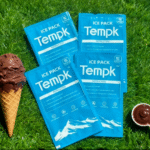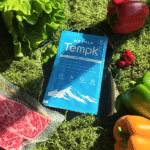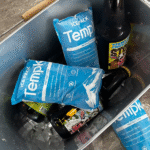Envasado de hielo seco Paquete de hielo seco: Que funciona en 2025?
Usando dry ice packaging dry ice pack correctly keeps frozen goods solid through real‑world delays and depot dwell. This guide gives you field‑tested sizing rules, packing SOPs, y 2025 compliance notes you can apply today. You’ll learn how to choose the right box, where to place the packs, and how much to use for 24–96 hours of protection without guesswork.
-
Cómo dry ice packaging dry ice pack compares to gel and PCM across seasons
-
How to estimate quantity with a fast, lane‑based method you can run on paper
-
How to pack step‑by‑step so cold sinks and hotspots vanish
-
Cual 2025 regulations matter for dry ice packaging dry ice pack by air and ground
-
How to cut cost per order without raising claim risk
-
¿Qué hay de nuevo en 2025: materiales, sensores, and greener liners
What is dry ice packaging dry ice pack, y cuando deberías usarlo?
respuesta rapida: Dry ice packaging dry ice pack means pairing a vented insulated shipper with solid CO₂ packs that sublimate at −78.5 °C to hold payloads below freezing. Use it whenever your product must stay ≤ −10 °C, como helado, carne, mariscos, postres congelados, or certain lab specimens. It outperforms gel packs for frozen lanes because sublimation soaks up heat predictably over time.
Por que funciona: Think of your box like a thermos and the pack like a cold engine. As CO₂ turns from solid to gas, it drinks up heat, while insulation slows outside warmth. If you top‑load the packs, cold air naturally sinks through the payload. Con dry ice packaging dry ice pack, you gain strong hold time per liter of box volume—especially useful when couriers reroute or hubs get congested.
Frozen e‑commerce lanes: dry ice packaging dry ice pack vs gel
Final: If the target is frozen, dry ice packaging dry ice pack wins on hold time per liter and resilience to hot afternoons. Gel excels for +2 to +8 °C lanes but struggles to keep the core truly frozen during long delays. A hybrid strategy—small dry ice plus gel guards near‑frozen desserts—can tame overshoot.
| Tipo de envío | Temperatura objetivo | Best Cooling Choice | Lo que significa para ti |
|---|---|---|---|
| Pintas de helado (verano) | ≤ −18 ° C | Dry ice packaging dry ice pack | Reliable texture on arrival; fewer refunds |
| Carne congelada & mariscos | ≤ −12 °C | Dry ice packaging dry ice pack | Longer buffers for late trucks |
| Kits de comida (enfriado) | +2 a +8°C | Gel/pcm | Menor costo, avoid frost damage |
| Shoulder seasons | −5 to −15 °C | Híbrido (small CO₂ + gel/pcm) | Prevents over‑freezing and carton brittleness |
Consejos y consejos prácticos
-
Top‑load first: Lugar dry ice packaging dry ice pack above the product so cold sinks naturally.
-
Ventilarse la tapa: Nunca selle CO₂; use a vented lid or a crack to release gas.
-
Reducir el vacío: Tighten inserts so packs “see” less empty air; this slows warmup.
-
Envolver la carga útil: Thin wraps tame frost and keep cartons clean at delivery.
-
Test the lane: One low‑cost data logger validates your recipe before you scale.
Caso real: A specialty seafood brand switched to dry ice packaging dry ice pack with top‑loading and added a 15% buffer for weekend risk. Summer claim rate fell from 6.4% a 1.9% across three zones while maintaining carton appearance and customer unboxing experience.
How much dry ice packaging dry ice pack do you need?
Field rule you can trust: Para rutas cálidas (20–30 ° C), plan 1.1–1.5 kg of dry ice per 10 L of internal volume per 24 hours. Usar 0.8–1.0 kg para rutas suaves (10–20 ° C) y 1.5–1.9 kg para rutas calientes (30–40°C). Start with the mid‑point, Entonces agregar 10–20% búfer para retrasos.
Simple five‑step method:
-
Measure internal L × W × H (litros).
-
Pick your route band: leve, cálido, o caliente.
-
Choose a rate from the table below.
-
Multiplicar por días (24 h blocks).
-
Round up and document the net kilograms of dry ice en la etiqueta.
| Banda de ruta | Perfil ambiental | kg per 10 L per 24 h | Por qué funciona |
|---|---|---|---|
| Leve | 10–20 ° C | 0.8–1,0 | Menor carga de calor; sublimación más lenta |
| Cálido | 20–30 ° C | 1.1–1,5 | Typical e‑com routes and afternoon peaks |
| Caliente | 30–40°C | 1.5–1.9 | larga permanencia, sun‑exposed delivery, olas de calor |
Ejemplo: A 24 L shipper, ruta cálida, 48 hours → 1.3 kg × (24/10) × 2 = 6.2 kg → add 15% = 7.1 kg total dry ice packaging dry ice pack.
Quick estimator you can copy
Fine‑tuning without complex math
-
Brittle cartons? Reducir el contacto directo: slip a thin corrugated shelf between pack and payload.
-
Edges thaw first? Add a narrow side strip of dry ice packaging dry ice pack to protect corners.
-
Overshoot too cold? Try a hybrid: 70–85% dry ice plus a small PCM at −10 °C to smooth extremes.
Cómo empacar: a step‑by‑step SOP for dry ice packaging dry ice pack
Core principle: Build a wrapped core, top‑load CO₂, Mantenga las ventilaciones abiertas, and lock down voids. Document the net kilograms and train every packer to the same recipe.
-
Pre‑stage the box: Add a bottom pad and corner inserts to reduce air swirl.
-
Prepara el núcleo envuelto.: Place products in a thin protective wrap; remove extra air.
-
Ajuste lateral ajustado: Insert side pads so the core doesn’t rattle.
-
Top‑load the packs: Lugar dry ice packaging dry ice pack above the core. Break large blocks into smaller chunks for even sublimation.
-
Ventilar y etiquetar: Use a vented lid. Marque "Hielo seco (Y 1845)” and the net kilograms.
-
Pesar y registrar: Registra el peso bruto, net CO₂, and packer ID in your system.
-
Prueba de batido final: If contents move, agregue material de estiba ligero hasta que esté cómodo.
Layouts that avoid hotspots
-
Tiered top layer: Two thin layers of dry ice packaging dry ice pack with a small gap in between spreads cooling.
-
Protección de bordes: Small strips along the long sides shield corners from ambient spikes.
-
Receiver safety: Add a bright “Vent Before Opening” note inside the lid for safer unboxing.
Compliance and safety for dry ice packaging dry ice pack
Essentials you should never skip:
-
denominación adecuada: "Hielo seco (Y 1845)" y peso neto en kilogramos en el paquete.
-
Desfogue: Do not seal CO₂. A vented lid or designed gas path is mandatory.
-
Compatible materials: Use liners and adhesives that tolerate −78.5 °C.
-
Documentación: Las cartas de porte aéreo deben indicar el hielo seco y la cantidad.; carriers may need a contact number.
-
Training and PPE: Gloves to handle packs, and awareness training for packers and receivers.
Aire vs.. suelo: Air shipments follow airline and IATA dangerous goods rules; ground shipments follow local transport rules (such as DOT/PHMSA in the U.S.). En la práctica, most couriers also publish their own dry‑ice instructions. Align your SOP with both the regulator and the carrier.
Safe handling checklist for your team
-
CO₂ stored in ventilated areas, never in sealed rooms or car trunks
-
Thermal gloves always at the pack station
-
No airtight coolers; siempre ventile la tapa
-
Receivers instructed to open in ventilated spaces and avoid direct skin contact
-
Emergency phone visible on the label for questions at delivery
Cost modeling: the TCO of dry ice packaging dry ice pack vs alternatives
What to optimize: You’re balancing coolant mass, tamaño de la caja, calidad de aislamiento, and damages. Dry ice packaging dry ice pack often reduces total cost because it shrinks claim rates and allows smaller, lighter shippers for the same frozen hold time.
| Cost Element | Envasado de hielo seco Paquete de hielo seco | Paquetes de gel | PCM (−10 to −21 °C) | Lo que significa para ti |
|---|---|---|---|---|
| Coolant cost per ship | Medio | Bajo a medio | Alto | CO₂ cheaper per watt‑hour than deep‑cold PCM |
| Box size required | Menor | Más grande (Para congelado) | Medio | Dry ice improves watts‑hour per liter |
| Damage/claim rate | Low when sized well | Higher for frozen | Medio | Fewer refunds and reships |
| Reutilizabilidad | Single‑use coolant | Paquetes reutilizables | Reutilizable | Gel/PCM reuse adds ops complexity |
| Training need | Moderado (desfogue, PPE) | Bajo | Moderado | Build SOP once; train quarterly |
Break‑even logic: If a stronger dry ice packaging dry ice pack recipe costs $1.20 more per order but cuts claims from 5% a 2%, a $40 AOV saves $1.20 in refunds—break‑even before you count saved reship freight or goodwill effects. Add reduced customer churn, and the richer recipe usually wins.
Pricing levers you control today
-
Tamaño adecuado: Decrease internal volume by 10–15% with better inserts; that alone can cut CO₂ mass.
-
Seasonal recipes: Use lighter recipes from October–April where climates allow, heavier from May–September.
-
Hybridization: A small −10 °C PCM tile can smooth spikes and reduce the total CO₂ by ~10% without warming the core.
QA and operations: running dry ice packaging dry ice pack at scale
Standardize the recipe: For each SKU and zone, publish a card with liters, route band, dry ice packaging dry ice pack kilogramos, and how many packs go into which layer. Add photos so temps are consistent across shifts.
Mide lo que importa:
-
Lane testing: Registro 1 de cada 20 boxes year‑round; topar con 1 en 10 during heat waves.
-
Depot discipline: Stage packed boxes off sun‑lit docks and away from heaters.
-
Weekend flag: If a scan projects weekend dwell, auto‑upgrade to a heavier recipe.
-
Receiver instructions: Include a one‑liner card about venting and safe handling inside the lid.
Autocomprobación de preparación (5 minutos)
-
Internal liters measured and on file
-
Dry ice packaging dry ice pack quantity printed on the pick ticket
-
Vented lid verified with a visible mark
-
Net CO₂ kilograms recorded on the shipping label
-
Data‑logger rotation assigned for the month
2025 trends in dry ice packaging dry ice pack
Descripción general de la tendencia (2025): The market is moving toward lighter boxes with higher R‑values per millimeter, curbside‑friendly liners, and smarter replenishment rules driven by route forecasts. Dry ice packaging dry ice pack remains the frozen benchmark, while hybrid PCM strategies grow for shoulder seasons and CO₂‑restricted networks. Expect cheaper Bluetooth loggers and more shipper designs with built‑in vent paths.
Avances at -a -glance
-
Fiber‑reflective liners: Paper‑based insulation with micro‑reflective films narrows the gap with foam while improving recyclability.
-
Mini registradores de datos bajo $20: Drop‑in validation for new lanes before peak season.
-
Route‑aware kitting: Packing apps that auto‑select mild/warm/hot recipes at the station.
Insight del mercado: Repeat‑purchase brands outpace one‑off sellers when frozen arrivals are reliably solid. A one‑point drop in claims can finance stronger dry ice packaging dry ice pack recipes the entire summer. Customers accept a slightly heavier box if the product quality is flawless at unboxing.
Preguntas frecuentes
Q1: How long will dry ice packaging dry ice pack keep items frozen?
Para rutas cálidas, plan 1.1–1.5 kg per 10 L per 24 h. Hot routes need 1.5–1.9 kg. Vent the lid and top‑load to avoid early warmups.
Q2: Is air shipping allowed with dry ice packaging dry ice pack?
Sí. Marque "Hielo seco (Y 1845)” and net kilograms. Provide ventilation and follow airline and IATA rules plus your carrier’s instructions.
Q3: How many packs should I use in a 15 L box for 48 h?
Warm route: target about 3.5–4.2 kg total, split across several smaller packs for even sublimation and fewer hotspots.
Q4: Does dry ice contact damage packaging or taste?
Direct contact can make cartons brittle or labels flaky. Use a thin product wrap and a spacer panel beneath the top layer of dry ice packaging dry ice pack.
Q5: ¿Cuál es la forma más segura de deshacerse de las sobras??
Deje que el CO₂ restante se sublime en un área ventilada.; mantener alejado de los niños y las mascotas. Nunca lo atrapes en recipientes sellados o desagües..
Q6: ¿Puedo mezclar hielo seco con paquetes de gel??
Sí. A hybrid can reduce overshoot and stabilize fringes. Keep gel below or beside the payload; mantener dry ice packaging dry ice pack arriba.
P7: What if my receiver opens the box in a small room?
Include a card: “Open in a ventilated area.” CO₂ is heavier than air and can displace oxygen in tight spaces. A quick reminder prevents risk.
Resumen y recomendaciones
Lo que más importa: Usar dry ice packaging dry ice pack when products must stay frozen. Shrink void space, top‑load the packs, and keep vents open. Size CO₂ by liters and route band, then add 10–20% buffer for delays. Etiqueta ONU 1845 y kilogramos netos, and train your team to a single SOP.
¿Qué hacer a continuación?:
-
Pick one lane that gives you trouble.
-
Run a data‑logger test with your current recipe and the SOP here.
-
Compare core temps at delivery and claim rates for two weeks.
-
Standardize the winning dry ice packaging dry ice pack recipe by season and zone.
Llamado a la acción: Share your box liters, route band, y tiempo de espera objetivo; we’ll return a right‑sized dry ice packaging dry ice pack plan you can test immediately.
Acerca de Tempk
We build practical cold‑chain packaging and planning tools for brands that ship frozen and chilled products. Our kits standardize insulation, dry ice packaging dry ice pack, receiver instructions, and label compliance so frontline teams can deliver consistent results. Two advantages stand out: field‑tested recipes that match real lanes, and simple calculators anyone can use during peak season.
Siguiente paso: Need a lane‑specific recipe? Share your box liters, route band, y tiempo de espera objetivo. We’ll respond with a right‑sized dry ice packaging dry ice pack plan you can test this week.
























